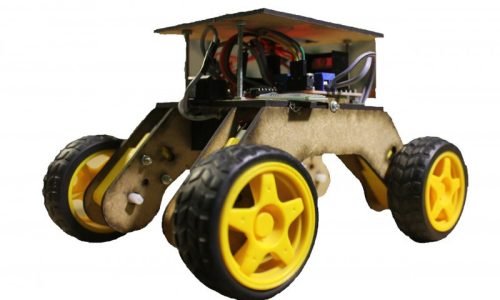Overview
Ever wondered how to control a robot with your smartphone? 🚀
In this course, you’ll learn the fundamentals of robotics, Arduino programming, and Bluetooth control to design and operate your own 4-wheel drive mobile robot. Using the PSC DIY Robotic Kit, participants will explore microcontrollers, sensors, and the integration of mechanical, electronic, and coding components that bring robots to life.
This is a hands-on, project-based course where you’ll not only build your robot but also program it to respond to time, sensors, and smartphone commands.
Who This Course is For
This course is perfect for:
- Students curious about robotics, coding, and electronics.
- Arduino enthusiasts who want to go beyond the basics.
- Learners from Mechanical, Electrical, Electronics, Computer Science, and Robotics backgrounds.
- Hobbyists who want to participate in robotics competitions like Robo Race, Robo War, or Robo Soccer.
Course Duration
📌 6 hours program – Learn step by step at your own pace.
Requirements
- Mandatory: PSC DIY Robotic Kit (Buy here)
- Basic knowledge of electronics is helpful (but not required).
- Computer/Laptop with Arduino IDE installed.
- Android smartphone with Bluetooth capability.
- Install this free app from Google Play to control your robot: Bluetooth RC Controller App
What You’ll Learn (Course Content & Overview)
1. Basics of Arduino
- Introduction to Arduino in simple Urdu/English.
- Setting up Arduino IDE on your laptop.
- Writing your first program to blink an LED.
2. Constructing the Robot
- Step-by-step assembly using the PSC kit.
- Understanding motors, motor driver, and chassis design.
3. Time-Control Robot
- Learn how a motor driver controls two DC motors.
- Write Arduino programs to make the robot move:
- Forward
- Backward
- Left / Right turns
- Radial & axial moves
- Stop
4. Serial Communication
- Learn how Arduino communicates with your PC.
- Read analog values from sensors.
- Send commands from computer → Arduino.
5. Controlling Your Robot with Smartphone
- Connect your Arduino robot to Bluetooth using the HC-05 module.
- Use the Bluetooth RC Controller App to send movement commands.
- Practice controlling your robot wirelessly in real-time.
Features
- 🎥 6 hours of on-demand video tutorials
- 📑 1 article & downloadable resources
- 🔑 Lifetime access to course materials
- 📜 Certificate of Completion
- 🤖 Hands-on learning with PSC DIY Robotic Kit
Next Steps
- Purchase the Kit → Get your PSC DIY Robotic Kit with lessons (Order here).
- Set Up & Assemble → Follow the guided modules to build your 4WD robot.
- Install the App → Download Bluetooth RC Controller to control your robot.
- Program & Control → Write Arduino code and practice wireless control.
- Modify & Compete → Customize your robot for fun, competitions, and creative projects.
- Get Support → Access PSC e-learning resources and community help whenever needed.
✨ By the end of this course, you’ll have built, coded, and wirelessly controlled your own Arduino-powered robot!
Features
- Hands‑On Learning: Assemble a 4‑Wheel Drive mobile robot using the Arduino UNO, Bluetooth module (HC‑05), and other core components.
- Full Kit Contents: Includes the Arduino UNO, L298 motor driver, HC‑05 Bluetooth module, battery, motors with wheels, chassis, power switch, charger, jumper wires, LEDs, metal spacers, nuts, and bolts.
- Microprocessor-Controlled: Program and control robot actions via your code and Bluetooth app—great for learning embedded system basics.
- Course Content: Comes bundled with 6 online lessons via PSC e‑learning platform, covering assembly, programming, and advanced modifications.
Target audiences
- Young students (12+) and hobbyists interested in beginner robotics and electronics.
- Schools, STEAM clubs, or extracurricular programs looking for hands-on robotic learning modules.
- Enthusiasts preparing for robotics challenges like Robo Race, Robo War, or Robo Soccer.
- Parents or educators seeking an engaging way to introduce algorithmic thinking, programming basics, and robotics.
- Android App Integration: Use the provided Android app to send commands wirelessly to your robot.
Requirements
- Purchasing the PSC DIY Robotic Kit with 6 Lessons (4‑wheel drive, Arduino‑based robotics kit) is mandatory to participate.
- Age Suitability: Recommended for learners aged 12 years and above.
- Technical Needs: A basic understanding of electronics or coding is helpful but not mandatory. Access to a smartphone with Bluetooth capability (for interfacing with the kit via the Android app)
- Basic tools (e.g., screwdriver set) for assembling the chassis and wiring components.
Curriculum
- 1 Section
- 7 Lessons
- 5 Hours
- Lessons7
FAQs
Instructor
PAKISTAN SCIENCE CLUB پاکستان سائنس کلب
inspires a lifelong interest in science, math and technology by engaging diverse communities through interactive and innovative programs

